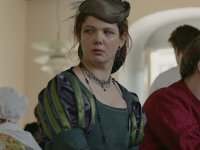Or why Galaxy Quest is the perfect larp.
In 1999, just before the millennium, the movie Galaxy Quest was released. In the movie, you follow a group of actors as they try to save the world of the Thermians by becoming the heroes they were in the TV show Galaxy Quest. But there is a caveat to this – when the Thermians saw the show, they thought they were watching a documentary, and they recreated everything from the spacecraft to the uniforms.
So, try to put yourself in the mind and body of the clueless actor: You are transported eight lightyears into space and are now on a working space craft, the Protector II. So how do you become the hero of the story, when you know absolutely nothing about how to fly a spacecraft or negotiate with an alien enemy?
When you larp you are often expected to do just that. But what can help you as a player to enter that space in your mind where everything becomes real? Is it the design, the space, the scenography – or something else entirely? To answer this question, I talked to Esperanza Montero of NotOnlyLarp, and player/designer, Sandy Bailly.

Inge-Mette Petersen at the larp Demeter. Photo by Larson Kasper.
I first met Esperanza Montero in 2018, when I played her Westworld-inspired larp Conscience in Fort Bravo, Almeria, Spain. Conscience is a large sprawling monster. Montero called it five larps in one with layers of reality that can be switched by a few select players, who play the plot writers that make the stories wanted by the guests happen. Playing an android host, the powerless doll in their plot, you are totally at their mercy. Conscience deals with the consequences of the choices you make on a political, moral, and ethical level, something that interests me. This is not a coincidence as Montero has a long experience as an LGBT+ activist and Pride organizer.
The next year, 2019, I went to Matera in Italy to play The Trial of the Shadowcasters, an urban larp by Bjarke Petersen and Mike Pohjola dealing with history and philosophy. Matera is a very special place, partly a cave city, so the scenography was a big part of the larp. I played with Sandy Bailly there in the caves and on the streets. I talked to her about the importance of locations for the players, and she had some interesting thoughts about this.
Both Fort Bravo and Matera are fascinating locations. But the perfect location does not exist. A larp can be built around a location or the location can be adopted to fit the larp design. The location and scenography can help the story and the players. A castle with lots of nooks and crannies is perfect for larps with a lot of secrets and politics. A small room for meetings is great for building up tension. And as Bailly says – it is great to have a space where you can see the world go by as your character. I have certainly done that.
The location is not enough, no matter how magical it is. A designer needs collaborators – prop makers, character writers and safety personnel. They need the organization for logistics and production, for catering, and administration. They need supporting characters to help move the story along. And they need to make the players understand the vision and the ideas behind the larp before they arrive on the scene. Then the larp starts, the players arrive – and all the plans of the organizers change. Bailly interprets larp as a framework for co-creation. If it is clear and well defined you can let people loose in it, so they can move around in it much more freely and securely.
Montero has a similar definition – larp is a collaborative art form where you all have a story to tell together. The players always have the power. The moment they get their character they start to make backstories, playlists, costumes, and relations. All that will also be part of the final game. But when the location, the design and the vision, and the characters as they are portrayed by the players all converge, larp magic happens. You truly believe in the story you are telling together.
And then the larp ends – or does it? For an organizer like Montero there is important work to do after the larp. Every aspect must be evaluated, the persons who have helped in realizing the project must be credited and the experience gained before, during, and after must be collected. Maybe the organizer wants to reiterate it, to take the players on the journey again.
The larp has been documented by photographers that captures a fleeting moment in the game. This picture becomes part of the players’ memory. Montero found it interesting how larp inspires creative people. She has seen essays, short stories, songs, comics, and even videos done by players after the larp has ended, a testimony to how real the story has become to them. For some it has been a deep personal experience that has changed their outlook on life. For others it was a great rollercoaster ride. And when they meet again at a larp, a convention, or a party, they will share memories. Maybe a catchphrase (“By Grabthars Hammer….”) or a ritual will be repeated. And why not – just as the actors in Galaxy Quest, they have been on a journey together and survived.
And maybe you want to join them. If you do – may you live long and prosper.
Cover photo: Image by Nathan Duck on Unsplash.
This article is published in the Knutpunkt 2022 magazine Distance of Touch and is published here with permission. Please cite this text as:
Petersen, Inge-Mette. 2022. “‘Never Give Up, Never Surrender’.” In Distance of Touch: The Knutpunkt 2022 Magazine, edited by Juhana Pettersson, 116-117. Knutpunkt 2022 and Pohjoismaisen roolipelaamisen seura.






